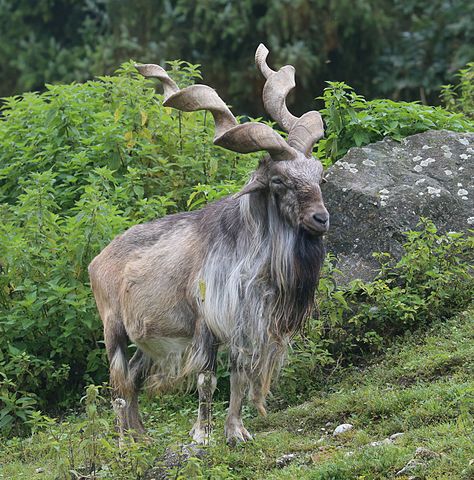United States citizen John Amistoso paid $100,000 to kill a rare markhor, also known as a ‘screw horn’ goat in Pakistan. The mystical looking creature is the national animal of Pakistan, however, reports state “fewer than 6,000 markhors exist in the wild.”
The markhor is also listed on The IUCN Red List Of Threatened Species. Despite this the local government still grants limited permits for markhor and other rare animals, “The Gilgit-Baltistan government auctioned a range of hunting permits for rare animals in October, starting the bidding at $100,000 for a markhor, $8,000 for a blue sheep and Rs100,000 (£560) for an ibex,” Independent reports.
The Culture Of Trophy Hunting
National Geographic explains the dangers associated with trophy hunting, “Trophy hunters, as well as poachers who “harvest” the big males—antelopes and deer with the largest horns and antlers, elephants with the longest tusks, or lions with the most impressive manes—are putting those species at greater risk of extinction with climate change.”
The results of a 2017 study by researchers at Queen Mary University of London state ‘trophy’ animals tend to be the most evolutionary advanced animals, possessing the high-quality genes a population of animals needs to adapt to rapidly changing environments.
An in-depth investigative report by National Geographic explains the culture of ‘trophy hunting’ in detail:
Trophy hunting—the killing of big game for a set of horns or tusks, a skin, or a taxidermied body—has burgeoned into a billion-dollar, profit-driven industry, overseen in some cases by corrupt governments. Many countries in sub-Saharan Africa allow trophy hunting, with varying degrees of transparency and control, establishing yearly quotas meant to reflect the status of species and creating exclusions for highly vulnerable populations. South Africa, for instance, no longer allows hunting of leopards. Kenya has banned trophy hunting outright since 1977, and in Botswana, a comparatively wildlife-rich country, a temporary ban in government-controlled hunting areas went into effect in 2014.
In the same report, Natasha Illum-Berg who leads ‘hunting experiences’ for trophy hunters defends the practice by saying that trophy hunting leads to anti-poaching measures, “I keep on saying: Give me a better idea than hunting as long as it’s sustainable. The big question in the end is, ‘Who’s going to pay for the party,’ ” she argues. Her argument fails to mention these efforts could be paid for by other means than hunting, ‘trophy hunting’ has been accepted due to how much money wealthy individuals are willing to pay.
The culture of ‘trophy hunting’ revolves around a group of individuals to be lead by a guide to the habitat of rare and protected animals. There isn’t much hunting actually involved, as in many cases the animals in these areas are not fearful of humans. What is pitched as a hunt is often simply an expensive round of target shooting.
United States President Donald Trump has had his sons draw critique for their ‘trophy hunting’ exploits. Donald Trump Jr and Eric Trump have been photographed numerous times with dead animals. “The Trump administration’s decision to loosen restrictions around the import of elephant trophies from Zimbabwe and Zambia has turned attention back to the president’s family’s own connection to the controversial sport. Donald Trump Jr and Eric Trump are prolific big-game hunters and during the 2016 campaign, images re-emerged of the pair on a 2011 hunting trip posing with animals they had killed on safari, including an elephant, a buffalo and a leopard,” The Guardian reported in 2017.
Will Trophy Hunting Ever End?
Concerning John Amistoso, he is a member of the Grand Slam Club which claims to be “an organisation [sic] of hunter/conservationists dedicated to improving and perpetuating wild sheep and goat populations worldwide.” In 2017 and 2018 he was photographed with the bodies of markhor subspecies of markhor from the Suleiman and Kashmir groups. Officials in Pakistan told reporters approximately 80 percent of the money raised from permits go the community and mountainous region where the animals were hunted.
Jeff Flocken of National Geographic disputes claims of ‘trophy hunting’ not harming local ecosystems, “Trophy hunting is also counter-evolutionary, as it’s based on selectively taking the large, robust, and healthy males from a population for a hunter’s trophy room. These are the same crucial individuals that in a natural system would live long, full lives, protecting their mates and cubs and contributing their genes to future generations.” Flocken also rebukes the claims of ‘trophy hunting’ helps local communities. “Despite the wild claims that trophy hunting brings millions of dollars in revenue to local people in otherwise poor communities, there is no proof of this. Even pro-hunting organizations like the International Council for Game and Wildlife Conservation have reported that only 3 percent of revenue from trophy hunting ever makes it to the communities affected by hunting. The rest goes to national governments or foreign-based outfitters.”




